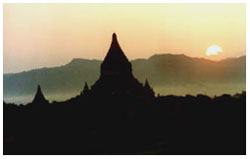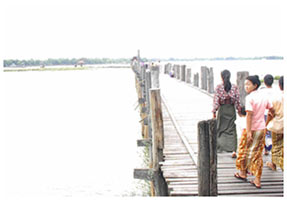
 |
Asterism Travels & Tours - Myanmar | Mandalay division - middle Myanmar |
|
States and divisions - Mandalay division  Mandalay division is a large lowland area between the Ayeyarwaddy river on the west and the Shan hills on the east.
The general elevation is around 150 meters above the sea, however the places on the east on the foot hills
of Shan plateau and the southern part situated on the northern Bago range are much higher.
Ayeyarwaddy river is the divisional border between Sagaing and Mandalay, as well as between Magwe and
Mandalay. Mandalay and Magwe divisions, together with lower Sagaing division form the central low land dry
zone of the country.
Mandalay division is a large lowland area between the Ayeyarwaddy river on the west and the Shan hills on the east.
The general elevation is around 150 meters above the sea, however the places on the east on the foot hills
of Shan plateau and the southern part situated on the northern Bago range are much higher.
Ayeyarwaddy river is the divisional border between Sagaing and Mandalay, as well as between Magwe and
Mandalay. Mandalay and Magwe divisions, together with lower Sagaing division form the central low land dry
zone of the country.
In the lowland the weather is hot, and the dry season is long. The hottest month is April when the temperature could reach 40ºC at day time. The summer generally occurs in February till July. Then comes the rainy season from June to October. November to middle of February is the cool season. The temperature difference between day time and night time is larger in the central plain than in other parts of the country. However the north-eastern parts such as May Myo (now called Pyin Oo Lwin) and Mogok both are on the Shan hills are much cooler. The nights in January could be as cold as near zero. Rainfall is one of the lowest in the country. The central triangle bounded by Mandalay, Myingyan and Yamethin is the driest part. In the dry areas the vegetation is scrubs, bushes, thorn bushes, htanaung, tamarind, toddy plam and so on. Wetter and higher lands such as Pyinmana (in the south, on Bago range), and May Myo and Mogok have greener forests with both hard wood and soft wood trees. Agriculture is the main economy with many of the farms growing dry zone crops including maize, millet, chillies, ground nut, sesame. Locally these are called "Yar". Instead of saying that people work in a farm ("Lae" in Myanmar words) people here say they work in the Yar. Rice, jute, cotton, sugar cane are also grown by the use of irrigation. Most of the rice fields here are wet system. Many islands on the Ayeyarwaddy river are used for farming crops like onions, chillies, tobacco, maize, tomatos, and other vegetables. These islands are covered with alluvium and very fertile. However some islands are not permanent, and liable to change or even be wiped out by floods or current. The farm on the islands are called "Kaing". Thus some farmers work in the "Kaing". Timber extractions could be seen in the southern tip and northern tip of the division. Teak and Pyinkado (iron wood) are extracted among others. Mogok is the country's leading producer of precious stones, and is famous for its rubies and sapphires. Most of the industries in the division are related to agriculture and forest products. Repair and building of transport equipment and accessories are found along the rail road and the water ways. Mandalay is the second biggest city in the country, and the center of commerce and trading for the upper Myanmar. It has a close trading relationship with both China and India. There are markets, distribution centers of both imported and local goods, private companies, government departments, schools and universities, private training schools, and so on. Cottage industries also play important role in the local economy. Mandalay is famous for sculpture works, gold and silver embroidery. Bagan and Nyaung U are popular for their lacquerware items. Transport and tourism  Mandalay is well connected to all major cities in the country. Yangon - Mandalay highway and rail road are
the country's two most travelled land routes.
By car people can travel to southern Shan state (Kalaw, Pindaya, Inle, Taunggyi). Train route to Taunggyi is
also finished, though it is a slow motion, in some places zip-zap climb, travel and not so popular among tourists.
Mandalay is well connected to all major cities in the country. Yangon - Mandalay highway and rail road are
the country's two most travelled land routes.
By car people can travel to southern Shan state (Kalaw, Pindaya, Inle, Taunggyi). Train route to Taunggyi is
also finished, though it is a slow motion, in some places zip-zap climb, travel and not so popular among tourists.
Yangon airways and Air Mandalay fly Mandalay to Heho, Kyaing Tone and Tachileik (border town between Shan state and Thailand's north) regularly. Mandalay to the China border at Muse is done by road which is not bad and used the whole year. Mandalay to Myitkyina in Kachin state is done by train that takes 24 to 30 hours. The rock and roll train leaves Mandalay and Myitkyina daily if there is no such problem as bad weather and rail damage. In the high water months (June to January) the double or triple decker boats run between Mandalay and Bhamaw 3 or 4 times a week. It takes two days and a night onboard. Perhaps, one of the most famous river route used often by foreign tourists is Mandalay to Bagan by Inland Water Transport (IWT). The boat leaves Mandalay at about 6AM and arrives Bagan in the evening. The arrival time depends on the water level and whether or not there are sand banks in the river. The tourist boat runs 3 or 4 days a week. On the other days there are other boats which are normally used by the local people and traders. Tourist boat is said to be cleaner and more comfortable. Being centrally located, Mandalay should be a base for expeditions to upper Myanmar such as Kachin, northern Sagaing, and northern Shan state. However, because these remotely located places require foreign tourists apply for the special permit at central government office in Yangon, most of the travel and tour operators' headquarters are located in the capital Yangon. Mandalay and Bagan have wide range of accommodations from budget to luxury hotels. May Myo, Mogok, Myithtila and Pyinmana have tourist class simple hotels. |